Electrofusion
Electrofusion is an advanced and widely used method for joining plastic pipes, especially polyethylene (PE). This technique is applied in various industries, including water, gas, and sewage systems. Due to its high precision and durability, electrofusion is considered one of the safest methods for pipe connections.
Components and Process of Electrofusion
Electrofusion Fittings: These fittings typically include couplers, elbows, tees, and other components, where heating wires are embedded. Electrofusion Machine: This device supplies the necessary electric current to heat the wires inside the fittings. Process:
- Pipe Preparation: The surface of the pipes is cleaned, and any potential oxide layer is removed.
- Pipe Placement in Fitting: The pipes are placed inside the coupler or corresponding fitting.
- Heating: The electrofusion machine sends an electric current to the heating wires inside the fitting. This heat causes the inner surface of the fitting and the outer surface of the pipe to melt.
- Cooling: After the current is turned off, the connection cools down and solidifies, creating a strong bond.
Advantages
- High Durability and Strength: The electrofusion joint is seamless and resistant to pressure and leakage.
- Ease of On-Site Execution: No bulky or complex equipment is required.
- Application in Harsh Conditions: Ideal for underground, humid, or difficult environments.
- High Safety: Suitable for gas and drinking water transmission systems.
Disadvantages
- High Initial Cost: Electrofusion machines and fittings are usually more expensive than traditional methods.
- Need for Training: Operators must have the necessary skills to use the equipment correctly.
Applications
- Natural gas transmission
- Water and sewage distribution systems
- Chemical transmission networks
- Civil and infrastructure projects
Key Considerations for Successful Electrofusion Execution
To ensure the quality and durability of electrofusion joints, the following points should be considered:
- Proper Preparation of Pipes and Fittings
- Cleaning: Any contamination, grease, or dust on the pipe and fitting must be thoroughly cleaned, often using isopropyl alcohol.
- Scraping the Pipe Surface: The pipe surface should be scraped to remove the oxide layer and create a suitable surface for melting.
- Drying: Ensure that the pipe and fitting surfaces are dry before starting the process.
- Proper Placement of the Pipe in the Fitting: The pipe should be correctly positioned and aligned inside the fitting. Any misalignment or movement can cause a defective joint.
- Electrofusion Machine Settings: The machine should be properly calibrated and adjusted for the type of fitting and environmental conditions. Many electrofusion fittings have barcodes that provide necessary information for machine settings (such as time and voltage).
- Cooling Process: After heating, the joint must be allowed enough time to cool. Moving or manipulating the joint during cooling may result in a faulty connection.
Difference Between Electrofusion and Butt Fusion
Electrofusion and Butt Fusion are two common methods for joining polyethylene pipes. They differ in the following aspects:
| Feature | Electrofusion | Butt Fusion |
|---|---|---|
| Joining Method | Using heating wires inside the fitting | Direct heat and pressure applied to both pipe surfaces |
| Required Equipment | Electrofusion machine and specialized fittings | Welding machine and heating molds |
| Application in Harsh Conditions | Suitable for confined spaces | Requires open and suitable space |
| Cost | Generally higher due to special fittings | Generally cheaper |
| Speed | Faster execution | May require more time |
Standards Related to Electrofusion
To ensure quality and safety, electrofusion must be conducted according to international and local standards. Some common standards include:
- ISO 12176-4: For electrofusion equipment
- ISO 4427: For polyethylene pipes in water transmission
- ASTM F1055: Standard for electrofusion fittings
- EN 12201: European standard for water and sewage systems
Challenges in Electrofusion
- Environmental Temperature: The process may be affected in very high or low temperatures. The equipment must be adjusted to suit environmental conditions.
- Quality of Raw Materials: Pipes and fittings must be made of high-quality polyethylene and comply with standards.
- Operator Skill: Correct execution of the process requires adequate operator training.

